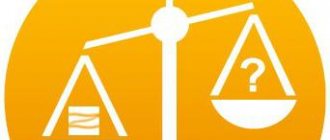Net assets
Definition
Net assets are a value determined by subtracting the amount of its liabilities from the total assets of the organization.
Net assets are the amount that will remain to the founders (shareholders) of an organization after the sale of all its assets and the repayment of all debts. The net asset indicator is one of the few financial indicators, the calculation of which is clearly defined by the legislation of the Russian Federation. The procedure for calculating net assets was approved by Order of the Ministry of Finance of Russia dated August 28, 2014 N 84n “On approval of the Procedure for determining the value of net assets.” This procedure is used by joint-stock companies, limited liability companies, state unitary enterprises, municipal unitary enterprises, production cooperatives, housing savings cooperatives, and economic partnerships.
Calculation (formula)
The calculation comes down to determining the difference between assets and liabilities (liabilities), which are determined as follows.
The assets accepted for calculation include all assets of the organization, with the exception of receivables of the founders (participants, shareholders, owners, members) for contributions (contributions) to the authorized capital (authorized fund, mutual fund, share capital), for payment of shares.
The liabilities accepted for calculation include all liabilities, except for deferred income.
.
But not all future income, but those recognized by the organization in connection with the receipt of government assistance, as well as in connection with the gratuitous receipt of property
. These incomes are actually the organization's own capital, therefore, for the purposes of calculating the value of net assets, they are excluded from the short-term liabilities section of the balance sheet (line 1530).
Those. The formula for calculating net assets on the Balance Sheet of an enterprise is as follows:
Net assets = (line 1600 - ZU) - (line 1400 + line 1500 - DBP)
where ZU is the debt of the founders for contributions to the authorized capital (it is not separately allocated in the Balance Sheet and is reflected as part of short-term receivables);
DBP – deferred income recognized by the organization in connection with the receipt of government assistance, as well as in connection with the gratuitous receipt of property.
An alternative way to calculate the net asset value, giving exactly the same result as the formula above would be:
Net assets = line 1300 - ZU + DBP
Normal value
The net asset indicator, known in Western practice as net assets or net worth, is a key indicator of the activity of any commercial organization. The organization's net assets must be at least positive. Negative net assets are a sign of the insolvency of an organization, indicating that the company is completely dependent on creditors and does not have its own funds.
Net assets must not only be positive, but also exceed the authorized capital of the organization. This means that in the course of its activities, the organization not only did not waste the funds initially contributed by the owner, but also ensured their growth. Net assets less than the authorized capital are permissible only in the first year of operation of newly created enterprises. In subsequent years, if net assets become less than the authorized capital, the civil code and legislation on joint stock companies require that the authorized capital be reduced to the amount of net assets. If the organization's authorized capital is already at a minimum level, the question of its further existence is raised.
Net asset method
In valuation activities, the net asset method is used as one of the methods for assessing the value of a business. With this method, the appraiser uses data on the organization's net assets according to the financial statements, previously adjusted based on its own estimated values of the market value of property and liabilities.
capital
Related publications
The organization's balance sheet presents many important financial indicators that characterize the company's business, including the cost of equity capital. At the moment, there are various ways to calculate such an indicator as equity capital - we will consider this below.
One of the main methods for calculating equity capital is based on the balance sheet data and is indicated in line 1300 “Total for section 3”. It consists of authorized capital, additional capital (also arising during the revaluation of fixed assets), reserve fund, as well as retained earnings.
In Russian legislation, the concept of equity capital often refers to net assets, which are formed from the balance sheet data by subtracting from the company’s assets (line 1600) all liabilities (lines 1400 and 1500), debts of participants and adding future income. This method helps participants and investors assess the value of a business.
There is also a method for determining equity for tax purposes when it comes to calculating income tax and there is controlled debt, that is, debt under a loan or credit when the person who issued the loan or security is a foreign company owning more than 20% of the borrower's share capital (directly or indirectly).
We must not forget that debt must exceed more than three times the amount of equity capital. For such borrowings, interest is not taken into account in expenses in full, but within certain limits (the “thin capitalization” rule). When we calculate equity capital for this case, then equity in the balance sheet is line 1300 “Total according to section. Ш" plus the borrower's tax debt.
I note that when it comes to tax arrears, this does not include arrears of contributions to funds (Pension Fund, Social Insurance Fund, Mandatory Health Insurance Fund).
Net assets on balance sheet (line)
Related publications
Net assets are the sum of the total lines 1100 and 1200 in the balance sheet, reduced by lines 1400 and 1500. The indicator is used to assess the stability of the financial condition and characterizes the real level of the business’s own funds after settlements of all obligations and debts. Let's consider how to determine the value of the NAV according to the accounting statements of an enterprise.
Net assets of the enterprise on the balance sheet
The cost of NA is calculated based on the results of the reporting period - a year or intermediate periods - a quarter, half a year, 9 months. The determination of net assets on the balance sheet is made by subtracting the debts of the liability section from the asset, applying adjustments to off-balance sheet accounts, debts of the founders/shareholders and income for future periods.
The calculation formula was approved by the Ministry of Finance of the Russian Federation in order No. 84n dated August 28, 2014 and is described in detail in a separate article. To calculate the size of an organization's net assets according to financial statements, the following mathematical algorithm is used:
NA = (line 1600 – Debts of the founders as part of receivables) – (line 1400 + line 1500 – Income of future reporting periods).
The net asset indicator is entered into the form for calculating the value of the net assets developed by the enterprise. It is allowed to use the form approved by the Ministry of Finance and the Federal Securities Commission in order No. 10n dated January 29, 2003. The result obtained may be positive or not. Negative net assets indicate unprofitable operations and possible insolvency of the company in the near future; they show the complete dependence of the business on external investments and loans. The exception is newly opened companies that have not yet received income.
Line 1300 of the balance sheet, code 1300
Usually a positive factor if accompanied by an increase in revenue and profit. Otherwise, it is a negative factor, especially if revenue and profit are declining faster than the decline in total assets.
Notes
The indicator in the article is considered from the point of view not of accounting, but of financial management. Therefore, sometimes it can be defined differently. It depends on the author's approach.
In most cases, universities accept any definition option, since deviations according to different approaches and formulas are usually within a maximum of a few percent.
The indicator is considered in the main free online financial analysis service and some other services
If you need conclusions after calculating the indicators, please look at this article: conclusions from financial analysis
If you see any inaccuracy or typo, please also indicate this in the comment. I try to write as simply as possible, but if something is still not clear, questions and clarifications can be written in the comments to any article on the site.
The concept of private equity is regulated by the Civil Code of the Russian Federation, defining them as a liquidity criterion for an organization, regardless of its organizational and legal form. Net assets are the difference reflected in the balance sheet between the value of all types of property of the institution (fixed and cash assets, land property, etc.)
d.) and the amount of established obligations (accounts payable of the organization). NA is the own capital funds of any enterprise, in other words, the capital property that will remain at the disposal of the institution after the repayment of all debts incurred to creditors and the sale of property assets.
The calculation of the value of net assets on the balance sheet must be carried out annually during the preparation and preparation of annual financial statements. The calculated NAV value demonstrates the real financial position of the enterprise as of the current date. The amount of net assets in the balance sheet is line 3600 in section 3 of the Statement of Changes in Capital.
The calculation of net assets is regulated by the Ministry of Finance of the Russian Federation through Order No. 84n dated August 28, 2014, which defines the concept of net assets - the formula. Its enforcement applies to the following types of organizational and legal forms of enterprises:
- public and non-public joint stock companies;
- LLC - limited liability company;
- SUE and MUP;
- production and housing savings cooperatives;
- business partnerships.
How to calculate net assets on the balance sheet is defined in Order No. 84n.
To calculate the NA, you can use the difference between their cost and liabilities:
NA = (VAO + OJSC – ZU – ZVA) – (DO + KO – DBP).
Let's decipher the main terms of this formula:
- VAO - non-current (JSC);
- OJSC - current JSC;
- ZU - debts of the founders to the institution for filling shares in the management company;
- ZBA - debt from the repurchase of own securities (shares);
- DO - long-term liabilities;
- KO - short-term liabilities;
- DBP is the profitability expected in future periods.
Indicator analysis
NA must be calculated to record the current financial condition of the enterprise. By studying their value, the owners draw conclusions about the efficiency and productivity of the business and make decisions on further investment or withdrawal of their funds. Net assets in the balance sheet, line 3600, demonstrate to the owners how profitable their cash investments and the institution's equity capital are.
They include two sections - current and non-current, grouped in ascending order, that is, by the level of liquidity of each indicator.
The structure, in accordance with Order No. 66n dated 07/02/2010, is presented in the table:
| Name | Assets on balance sheet - line | Characteristic |
| Non-negotiable | ||
| Intangible | 1110 | Patents, licenses, organizational expenses. |
| Research and development results | 1120 | Inventions, computer software. |
| Search intangible assets | 1130 | Used natural resources and subsoil resources. |
| Search MA | 1140 | |
| OS | 1150 | Buildings and structures, machinery, equipment, land. |
| Profitable investments in MC | 1160 | Property for leasing. |
| Financial investments | 1170 | Investments, participation in the authorized capital of other companies, loans. |
| Deferred tax | 1180 | Account 09 is part of the deferred income tax, which is aimed at reducing the income tax payable in subsequent reporting periods (using PBU 18/02). |
| Other VBA | 1190 | Funds and investments not included in other groups. |
| Negotiable | ||
| Reserves | 1210 | Finished products, raw materials, supplies. |
| VAT on purchased assets | 1220 | The amount of “input” VAT that was not reimbursed from the budget. |
| Accounts receivable | 1230 | The assets of the balance sheet reflect receivables for which payments are expected within or more than 12 months after the reporting date. |
| Financial investments other than cash equivalents | 1240 | Investments in securities of other companies, interest-bearing bonds of state and local loans. |
| Cash and equivalents | 1250 | The total amount of cash equivalents held by an organization. |
| Others | 1260 | OA not included in other groups. |
Everyone who has ever held a balance sheet in their hands, much less drawn it up, paid attention to the “Code” column.
report for the previous year revaluation of property 3212 (3312) Capital gain due to revaluation of property (Credit turnover - Debit turnover) for accounts: 83 (column 5) , 84 (column 7) in correspondence with accounts: 01 , 02, 03, 04, 05, 08 page 3212 = page 3312 of the report for the previous year income attributable directly to the increase in capital 3213 (3313) Capital gain due to deposits of founders Credit turnover on accounts: 83 (column 5) , 84 (column 7) in correspondence with accounts: 50, 52, 60, 62, 75, etc. line 3213 = line 3313 of the report for the previous year additional issue of shares 3214 (3314) Capital gain due to additional contributions to the authorized capital, share premium, etc.
Result from the revaluation of non-current assets, not included in the net profit (loss) of the period 2510 Change in the amount of additional capital as a result of the revaluation of non-current assets (Credit turnover - Debit turnover) in account 83 in correspondence with accounts: 01 , 02, 03, 04, 05, 08 Result from other operations not included in the net profit (loss) of the period * 2520 Changes in capital not related to settlements with the owners of the company Turnovers on capital accounts (excluding revaluation of non-current assets) Cumulative financial result of the period 2500 Adjusted net profit (loss) page 2500 = page 2400 + page 2510 + page
Important However, not all companies can get by with only the “standard” lines of this reporting - many require expanded detail. Therefore, sometimes additional items are used, for example, to line 1260 “Other current assets,” a detailing line 12605 “Deferred expenses” is opened.
The balance sheet in the language of accounting legislation was previously called Form 1.
Another reporting document - “Statement of financial results” - was called Form 2. It is in Form 2 that there is line 2110, which reflects the revenue received during the reporting period.
Net assets of a joint stock company
Net assets in the balance sheet of the joint-stock company, line 3600 section. 3 statements of changes in capital are calculated according to the formula used by LLCs and enterprises of other forms of ownership. Joint-stock companies calculate the NAV before paying dividends to shareholders, when a shareholder leaves the business, to determine the ratio between the authorized capital and the amount of net assets, in the case of purchasing placed shares or when repurchasing shares owned by the company.
What is a comparative analytical balance sheet of net assets?
A similar analysis is carried out to study the dynamics of changes in the financial condition of the enterprise. At the same time, absolute and specific ratios are calculated at the beginning/end of the reporting period for individual indicators and the overall picture of the state of affairs in the organization is determined. The calculations use various indicators, formulas and coefficients. For example, the method for determining the value of own working capital (SOC):
SOS = Own sources (section 4 of the balance sheet) – Non-current assets (section 1 of the balance sheet).
Conclusion - to find out where the net assets are on the balance sheet, it is necessary to calculate the amount of the company's own funds, not encumbered with liabilities. The cost is determined in monetary terms as of the latest reporting date based on accounting data.
How to calculate sources of own funds?
Section 3 refers to the liability side of the balance sheet and contains digital indicators characterizing the capital and reserves of the organization, namely:
· Authorized capital.
· Own shares purchased from shareholders.
· Revaluation of non-current assets.
· Extra capital.
· Reserve capital.
· Retained earnings (uncovered loss).
Authorized capital (share capital, authorized capital, contributions of partners) (line 1310) - indicates the amount of the authorized capital of the organization at the end of the reporting period, fixed in the constituent documents.
The balance sheet indicators on line 1310 do not contain information about changes in capital.
The previous line 210 corresponds to the current line 1210 of the balance sheet; the accounting department enters data on the remaining inventories into it.
Line 1220 of the balance sheet in the previous version is line 220. It should contain data on VAT, which was issued by the supplier, but was not accepted for deduction until the report was drawn up. This is essentially the debit balance of account 19.
Line 1240 of the balance sheet with a breakdown was previously line 250. It reflects investments whose maturity does not reach a year.
Line 1250 is the company’s monetary assets in national and foreign currencies, as well as other resources. This refers to accounts 50, 51, 52 and 55.
Line 1260 contains all other assets that did not find a place in the above section lines.
Line 1200 in the previous version of the form was line 290 of the balance sheet. The final results for section 2 are reflected here.
when filling out line 1300 “Capital and reserves”
When filling out the line “Capital and reserves”, data on credit balances on accounts 80, 82, 83, debit balance on account 81, balance on account 84 as of the reporting date can be used.
┌───────────────────────┐ ┌─────────────────┐ ┌─────────┐ ┌─────────┐
│Line 1300 “Capital and │ │Credit balances│ │Debit│ │Balance by│
│reserves" of Accounting│ = │accounts 80, 82,│ - │balance on│ + │account 84 │
│balance │ │83 │ │account 81 │ — │ │
└───────────────────────┘ └─────────────────┘ └─────────┘ └─────────┘
The comparative indicators of the line “Capital and reserves” (indicators as of December 31 of the previous year and as of December 31 of the year preceding the previous one) are transferred from the Balance Sheet for the previous year.
commercial organizations - small businesses are not entitled to use simplified methods of accounting if they are microfinance organizations or their financial statements are subject to mandatory audit (clause 1, 4, part 5, article 6 of Law No. 402-FZ).
The procedure for filling out this line by small businesses does not differ from the generally established procedure for filling out line 1410 “Borrowed funds” section. IV Balance Sheet, the form of which is given in Appendix No. 1 to Order of the Ministry of Finance of Russia No. 66n.
For information about what obligations of the organization are taken into account as part of borrowed funds, how their value is determined and what accounting data is used when filling out line 1410 “Borrowed funds”, see section. 3.1.4.1 “Line 1410 “Borrowed funds”.
For an example of filling out line 1410 “Borrowed funds”, see section. 3.1.4.1.4.
3.6.1.9. Line “Other long-term liabilities”
On this line, small business organizations reflect all long-term liabilities existing as of the reporting date (with the exception of those reflected on line 1410 of long-term borrowed liabilities). Long-term obligations are understood as obligations whose maturity exceeds 12 months after the reporting date (clause 19 of PBU 4/99).
Attention!
Small business organizations (with the exception of issuers of publicly offered securities) have the right not to apply the Accounting Regulations “Estimated Liabilities, Contingent Liabilities and Contingent Assets” (PBU 8/2010) and the Accounting Regulations “Accounting for Income Tax Calculations of Organizations” » PBU 18/02. If an organization uses this right, then estimated liabilities and deferred tax liabilities are not recognized in its accounting.
From November 16, 2014, commercial organizations - small businesses are not entitled to use simplified methods of accounting if they are microfinance organizations or their financial statements are subject to mandatory audit (clause 1, 4, part 5, article 6 of Law No. 402 -FZ).
Date added: 2016-03-15; ;
This page shows the balance sheet with accounts.
How should balance sheet indicators be interrelated?
The accounts are shown according to the chart of accounts, which is also available on the website. This balance sheet has been prepared to facilitate understanding of the relationship between the accounting accounts and the balance sheet figures. In contrast to the regulated form in which enterprises prepare reports, a column has been added to the balance sheet indicating the accounting accounts, the balances of which can be reflected in one or another line of the balance sheet. To make it easier to understand, the decoding “including” has been added to some balance lines. So, for example, as can be seen below, the concept of “inventories” includes raw materials, work in progress, goods, etc. In the approved balance sheet form, this is one line and filling it out for beginners causes great difficulties. If a task requires filling out a balance sheet according to an approved form, then the “including” decoding lines must be summed up and the result included in the final line.
69 Regulations on accounting and financial reporting).
Line 1360 “Reserve capital” of the Balance Sheet = Credit balance of account 82 + Credit balance of account 84 (in terms of special funds).
The article “Retained earnings (uncovered loss)” - line 1370.
This line reflects the amount of retained earnings or uncovered losses of the organization.
The amount of retained profit (uncovered loss) of the reporting period is equal to the amount of net profit (net loss) of the reporting period, i.e. profit (loss) after tax:
— reduced by the amount of accrued interim dividends;
— increased by the amount of additional capital from the revaluation of fixed assets and intangible assets retired in the reporting period (clause 15 of PBU 6/01, clause 21 of PBU 14/2007);
— adjusted by the amount of increase in the authorized capital due to retained earnings (reduction of the authorized capital when it is brought to the value of net assets).
Line 1370 “Retained earnings (uncovered loss)” of the Balance Sheet = + - Account balance 99 + - Account balance 84.
Article “Total for Section III” - line 1300.
The indicator of this line is the sum of the indicators for the lines of section. III with codes 1310 - 1370 and reflects the total capital of the organization.
Line 1300 of the Balance Sheet = Line 1310 of the Balance Sheet – Line 1320 of the Balance Sheet + Line 1340 of the Balance Sheet + Line 1350 of the Balance Sheet + Line 1360 of the Balance Sheet + - Line 1370 of the Balance Sheet.
Section IV “Long-term liabilities”.
Line 1100 contains information about the full amount of non-current assets of the enterprise. Before the order was changed, this was line 190. The next 6 lines are elements that add up to the value of this line.
Line 1150 of the balance sheet with a transcript corresponds to the previous line 120. Data on the enterprise’s fixed assets available at the time of the report is entered into it.
Line 1160 reflects information about the amount of material assets available at the enterprise, as well as investments that generate income. All data is recorded on account 03.
Line 1170, former 140, contains data on the enterprise’s investments if they are made for more than 12 months. Accounting is maintained by the debit of accounts 58 and 55, the subaccount is called “Deposits”.
Line 1180 contains the allocated tax assets. The balance of account 09 is indicated here. Line 1190 includes all non-current assets that were not mentioned above.
The previous line 210 corresponds to the current line 1210 of the balance sheet; the accounting department enters data on the remaining inventories into it.
Line 1220 of the balance sheet in the previous version is line 220. It should contain data on VAT, which was issued by the supplier, but was not accepted for deduction until the report was drawn up. This is essentially the debit balance of account 19.
Line 1240 of the balance sheet with a breakdown was previously line 250. It reflects investments whose maturity does not reach a year.
Line 1250 is the company’s monetary assets in national and foreign currencies, as well as other resources. This refers to accounts 50, 51, 52 and 55.
Line 1260 contains all other assets that did not find a place in the above section lines.
Line 1200 in the previous version of the form was line 290 of the balance sheet. The final results for section 2 are reflected here.
Not standardized
Not standardized
Usually a positive factor, especially if accompanied by faster revenue and profit growth. Otherwise, it is a negative factor.
If net assets are less than authorized capital
If your company's net assets have become less than its authorized capital, then you are obliged to reduce the authorized capital to the level of net assets and register such a decrease in the Unified State Register of Legal Entities (clause 4 of article 90 of the Civil Code of the Russian Federation, clause 3 of article 20 of the Law of 02/08/98 N 14 -FZ). That is, at least after drawing up the annual financial statements, you need to compare the authorized capital and net assets.
In addition, the following rule applies. If an LLC decides to pay dividends to participants, but as a result of accrual of dividends, the value of net assets becomes less than required, then dividends cannot be accrued in the planned amount. It is necessary to reduce the profit distributed on dividends to an amount at which the above ratio will be satisfied.
At the same time, no liability has been established for violation of the requirement for the ratio of authorized capital and net assets.
General concepts
Successful business conduct is impossible without a detailed analysis of the financial and economic indicators of the economic activity of an economic entity. In order to assess the property and financial position of an organization and make the right management decisions in a timely manner, it is necessary to determine important solvency and profitability ratios. One of the key calculation indicators is the calculation of the value of net assets on the balance sheet.
The organization's net assets (NA) are the amount of funds of an economic entity, determined by calculation, which will remain at the disposal of the company after full repayment of debt obligations. In other words, the value of net assets is calculated as the arithmetic difference between the total indicators of the company’s property, material and financial assets and assumed liabilities.
Note that calculating the value of net assets on the balance sheet is mandatory for organizations. The indicator is calculated once a year based on accounting data. Indicators are reflected in the third section of the report on changes (movements) of capital; net assets are (in the balance sheet) line 360 of this reporting form.
What are they made of?
They include two sections - current and non-current, grouped in ascending order, that is, by the level of liquidity of each indicator.
The structure, in accordance with Order No. 66n dated 07/02/2010, is presented in the table:
| Name | Assets on balance sheet - line | Characteristic |
| Non-negotiable | ||
| Intangible | 1110 | Patents, licenses, organizational expenses. |
| Research and development results | 1120 | Inventions, computer software. |
| Search intangible assets | 1130 | Used natural resources and subsoil resources. |
| Search MA | 1140 | |
| OS | 1150 | Buildings and structures, machinery, equipment, land. |
| Profitable investments in MC | 1160 | Property for leasing. |
| Financial investments | 1170 | Investments, participation in the authorized capital of other companies, loans. |
| Deferred tax | 1180 | Account 09 is part of the deferred income tax, which is aimed at reducing the income tax payable in subsequent reporting periods (using PBU 18/02). |
| Other VBA | 1190 | Funds and investments not included in other groups. |
| Negotiable | ||
| Reserves | 1210 | Finished products, raw materials, supplies. |
| VAT on purchased assets | 1220 | The amount of “input” VAT that was not reimbursed from the budget. |
| Accounts receivable | 1230 | The assets of the balance sheet reflect receivables for which payments are expected within or more than 12 months after the reporting date. |
| Financial investments other than cash equivalents | 1240 | Investments in securities of other companies, interest-bearing bonds of state and local loans. |
| Cash and equivalents | 1250 | The total amount of cash equivalents held by an organization. |
| Others | 1260 | OA not included in other groups. |
The totals reflected in line 1600 must correspond to the total result in line 1700.
An organization's equity capital refers to the totality of funds available to the company. Or rather, funds belonging to the participants of the organization. How is the amount of an organization’s equity capital determined based on the balance sheet data?
Formula for calculating net assets
The key procedure for calculating the value of net assets on the balance sheet is determined by the Ministry of Finance of the Russian Federation and is presented in a separate order No. 84n dated August 28, 2014. Please note that previously a different procedure was in effect, but it is not currently used.
This formula for net assets on the balance sheet is applicable to the following range of economic entities:
- public or non-public joint stock companies;
- state or municipal unitary enterprises;
- limited liability companies;
- production cooperatives or housing cooperatives;
- business partnerships.
Net assets formula:
- JSC - the amount of non-current and current assets of an economic entity as of the reporting date;
- DE - debt of the founder incurred to the enterprise for the formation of the authorized capital;
- FOR - debt on own shares generated upon issue;
- OB - the sum of the company's short-term and long-term liabilities;
- DBP - future income in the form of state financial support or gratuitous transfer of property assets.
How to calculate net assets according to balance sheet lines?
To calculate the net asset value on the balance sheet, the calculation lines use the following:
Calculating the amount of net assets in the balance sheet (the lines indicated above) using a pencil calculator is not enough. This calculation must be documented. However, a unified form for reflecting calculated data is not provided for in Order No. 84n. Organizations are required to independently develop a form and regulate it in their accounting policies.
Note that before the approval of Order No. 84n, the old form was in force (Order of the Ministry of Finance of the Russian Federation No. 10 and the Federal Commission for the Securities Market of Russia dated January 29, 2003 No. 03-6/pz). In the new instructions, the Russian Ministry of Finance has not prohibited the use of this form, therefore, firms can use it to prepare calculations of net assets in the balance sheet (the document lines contain all the necessary information).
Equity. Balance formula
Own capital consists of balance sheet liability items - authorized capital, share capital and contributions of partners (line 1310), additional capital (line 1350), reserve fund (line 1360), retained earnings (line 1730) and so on.
The formula for equity on the balance sheet is quite simple. Own capital in the balance sheet is line 1300 “Total” under section III “Capital and reserves”. For example, let’s find our own funds in the balance sheet of Soyuz LLC. Data as of December 31:
— authorized capital — 10 thousand rubles;
— revaluation of non-current assets — 50 thousand rubles;
— retained earnings — 1000 thousand rubles.
Own capital is equal to 1,060 thousand rubles. (10 thousand rubles + 50 thousand rubles + 1000 thousand rubles).
The amount of authorized (share) capital is reflected in the balance sheet in accordance with the registered charter of the company; it represents the contributions of the founders (participants, shareholders) of the company. For LLCs, the minimum size of the capital is 10,000 rubles, for public joint-stock companies 100,000 rubles, and for non-public joint-stock companies the same 10,000 rubles. It can be made both in cash and in non-cash (securities, property rights, etc.), and there must be an independent assessment of such a contribution. State-owned companies have an authorized capital instead of an authorized capital. You can find the size of the authorized capital in line 1310 of the balance sheet.
When a company overvalues non-current assets, when selling shares or shares, receives an amount in excess of the nominal value, or receives gratuitous assistance as a contribution to the property of the company, then this is accounted for as additional capital.
A reserve fund is created from the company's profits to compensate for possible losses, including in the case of outstanding accounts receivable. The amount of the reserve is determined separately for each doubtful debt. Joint-stock companies are required to create it; for an LLC, such an obligation is provided for in the charter. In the balance sheet, reserve capital is reflected in line 1360 “Reserve capital”.
When the profit remains at the disposal of the company, has not gone to taxes and has not been distributed among the participants (shareholders), it is reflected in account 84 “Retained earnings (uncovered loss).” Retained earnings have the right to be spent only by decision of the owners; they can use it for dividends or to increase the authorized capital. You can also use profits to cover last year's losses.
Section 3 refers to the liability side of the balance sheet and contains digital indicators characterizing the capital and reserves of the organization, namely:
· Own shares purchased from shareholders.
· Revaluation of non-current assets.
· Retained earnings (uncovered loss).
Authorized capital (share capital, authorized capital, contributions of partners) (line 1310) - indicates the amount of the authorized capital of the organization at the end of the reporting period, fixed in the constituent documents.
The balance sheet indicators on line 1310 do not contain information about changes in capital.
The explanation for line 1310 “Authorized capital (share capital, authorized capital, contributions of partners)” of the balance sheet is the Statement of Changes in Capital.
Please note: The indicator in line 1310 of the balance sheet must correspond to the indicator in the “Authorized Capital” column of the line “Capital Amount as of December 31, 2013.” (line 3300 ) Statement of changes in capital.
Own shares purchased from shareholders (line 1320) - indicates the amount of the debit balance in account 81 “Own shares (shares)” at the end of the reporting period.
Own shares/shares purchased from shareholders/participants are reflected in the financial statements in the amount of actual costs for their redemption, regardless of the nominal value.
Please note: The indicator in line 1320 of the balance sheet must correspond to the indicator in the column “Own shares purchased from shareholders” of the line “Capital value as of December 31, 2013.” (line 3300 ) Statement of changes in capital.
This indicator is reflected in parentheses.
Revaluation of non-current assets (line 1340) – the credit balance is indicated in account 83 “Additional capital”, in terms of revaluation of non-current assets, at the end of the reporting period, taking into account the revaluation carried out as of December 31, 2013.
Please note: Revaluation of fixed assets is carried out by recalculating their residual or current (replacement) value (if this object was revalued previously), and the amount of depreciation accrued for the entire period of use of the object (clause 15 of PBU 6/01).
Revaluation of intangible assets is carried out by recalculating their residual value (clause 19 of PBU 14/2007).
Additional capital (without revaluation) (line 1350) – indicates the amount of the credit balance in account 83 “Additional capital” at the end of the reporting period, minus the amounts of the credit balance formed in connection with the revaluation of assets.
Amounts of additional capital include, for example, the excess of the selling price of shares/shares over their nominal value.
Reserve capital (line 1360) – indicates the amount of the organization’s reserve capital at the end of the reporting period.
This line reflects the amounts of reserve (and other) funds formed in accordance with the constituent documents and provisions of the current legislation.
In accordance with clause 1 of Article 30 of Law No. 14-FZ “On Limited Liability Companies”, the Company may create a reserve fund and other funds in the manner and in the amounts established by the company’s charter.
In accordance with clause 1 of Article 35 No. 208-FZ “On Joint-Stock Companies,” a reserve fund is created in the company in the amount provided for by the company’s charter, but not less than 5 percent of its authorized capital.
The reserve fund of the company is formed through mandatory annual contributions until it reaches the size established by the charter of the company.
The amount of annual contributions is provided for by the company's charter, but cannot be less than 5 percent of net profit until the amount established by the company's charter is reached.
The company's reserve fund is intended to cover its losses, as well as to repay the company's bonds and repurchase the company's shares in the absence of other funds.
The reserve fund cannot be used for other purposes.
We recommend that the procedure for creating reserve (and other) funds, as well as the procedure for contributions to these funds, be fixed in the accounting policy for accounting purposes and reflected in the explanatory note to the statements.
Please note: The indicator in line 1360 of the balance sheet must correspond to the indicator in the column “Reserve capital” in the line “Capital value as of December 31, 2013.” (line 3300 ) Statement of changes in capital.
Retained earnings (uncovered loss) (line 1370) – indicates the amount of retained earnings (uncovered losses) reflected at the end of the year in account 84 “Retained earnings (uncovered loss)”.
Please note: The indicator in line 1370 of the balance sheet must correspond to the indicator in the column “Retained earnings (uncovered loss)” of the line “Capital value as of December 31, 2013.” (line 3300 ) Statement of changes in capital.
The indicator on line 1370 is indicated without brackets if the balance is positive (when reflecting retained earnings) and in parentheses if the result is negative (when reflecting uncovered losses).
Total for section III (line 1300) – indicates the total amount of the organization’s equity capital at the end of the reporting period.
Line 1300 = line 1310 + line 1320 + line 1340 + line 1350 + line 1360 + line 1370.
Please note: The indicator in line 1300 of the balance sheet must correspond to the indicator in the “TOTAL” column of the line “Capital value as of December 31, 2013.” (line 3300 ) Statement of changes in capital.
How to calculate net assets on a balance sheet, example
Let's look at a specific example of how to calculate net assets on a balance sheet.
Vesna LLC prepared annual financial statements, including a balance sheet in the OKUD form 0710001.
Based on the balance sheet data, the following calculations were made:
NA = (13,800 +19,283 – 0) – (12,930 – 0) = 20,153 rubles.
Analysis of indicators
Having completed the arithmetic calculations, we move on to analyzing the result obtained. With a positive amount of net assets in the balance sheet, we can conclude that the company is profitable and has high solvency. And, accordingly, the higher the indicator, the more profitable the enterprise.
Negative net assets are an indicator of the low solvency of an enterprise. In other words, a company with a negative NAV will most likely go bankrupt soon; the company will simply have nothing to pay off its debts. However, in such a situation, exceptional circumstances must be taken into account. For example, the company has just been formed and has not yet covered its costs, or the company received a large loan for expansion.
An increase in net assets can be achieved by increasing the authorized, reserve or additional capital or by reducing the founder’s debts to the enterprise.







